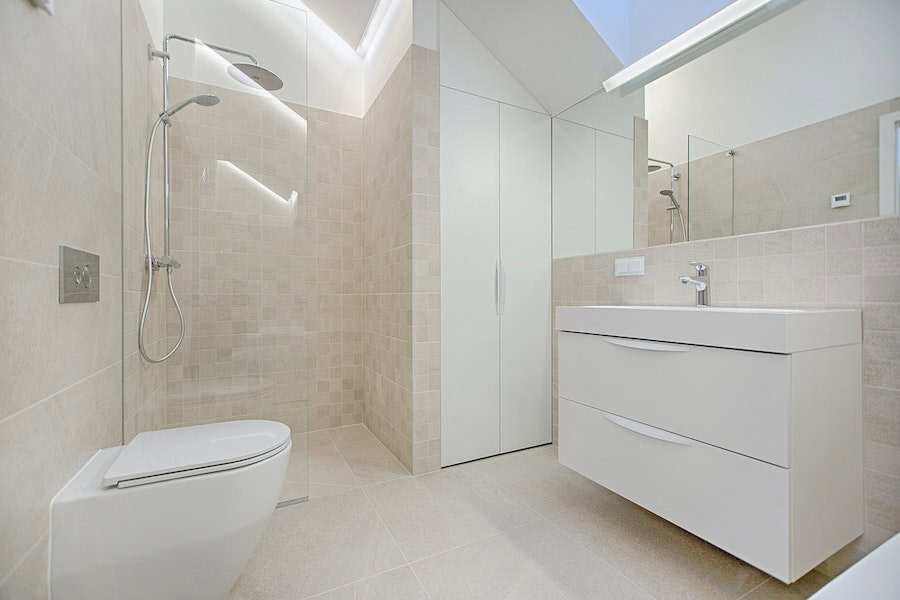
Installing a wet room is a sensible home improvement choice that, if done well, can improve your home’s value. Aside from being a smart choice for people with limited mobility, modern wet rooms can be stylish, modern, and extremely convenient.
Level flooring means that they are easy to keep clean, but when it comes to flooring, you do need to make sure you choose the right materials. This article will discuss wet room flooring and what needs to be considered before installation.
Types of wet room flooring
1. Tiles
Tiles are a standard choice for wet room flooring. As well as looking great, they can easily be fitted from floor to ceiling to give a seamless, easy-to-clean look. Most wet room under-floor trays are designed with tiles in mind, so they fit in easily. This is a simple, no-fuss choice. The only thing to consider it that re-grouting will have to be done eventually. There are the most commonly used types of tiles for wet rooms:
- Porcelain – these tiles are less porous and are denser than other alternatives, making them suitable for flooring.
- Natural stone – looks good and helps to provide a natural grip that prevents slipping.
- Mosaic tiles – mosaic tiles help to produce the slope that is necessary to channel water runoff towards the drains in the room.
2. Vinyl
Vinyl is another sensible choice for wet room flooring. It is more cost effective than tile and is usually better for commercial installations like gyms and schools. Vinyl is a hardy material that will last for a long time if treated well, and it gives a ‘seamless’ look which appeals to a lot of people. It comes in a massive range of designs – from a fake tile look to marble aesthetics. As well as its looks, vinyl is non-slip and has excellent waterproof qualities, protecting the floor beneath from leaks and damp.
3. Micro-cement
Micro-cement is a desirable material to use in wet rooms. One of its core benefits is that it is a lot more cost-effective to install than tile and doesn’t require as much effort as natural stone does to install. It is completely waterproof and its seamless installation makes it one of the most hygienic materials for a wet room, especially in commercial settings like care homes where disinfection is a priority.
What else to consider
Installing underfloor heating
Underfloor heating is a sensible add-on to install alongside your new wet room and wet room flooring, especially if the ventilation in the room is not the best. It keeps floors at a comfortable temperature and helps them to dry more effectively after the user has had a shower, helping to prevent any slip risk and stopping damp from forming.
Installing underfloor heating also means that you don’t need to rely on a space-wasting radiator to get the room up to temperature. Removing radiators might be necessary for safety if the room is being used by someone who isn’t too steady on their feet and may grab onto the heated appliance to steady themselves, causing accidents. UFH ensures the room can stay warm whilst remaining invisible and out of the way.
Both wet and electric underfloor heating systems are ideal for this application, and both can be installed under the main flooring and directly under the shower tray.
Look at our range of bathroom underfloor heating
Checking anti-slip rating
When choosing wet room flooring, you need to consider their anti-slip rating. Since your wet room is designed to be covered in water, this is of extreme importance. According to the Health and Safety Executive, flooring being used in wet conditions for barefoot users should have a good slip resistance[1].
Slip resistance is measured on a classification scale of A – C, with A being the slippiest surface, and C being the least slippery. Keep this in mind when ordering flooring for your wet room.
Consult an expert before you install
Before you start drawing up your plans, you need to speak to an expert installer about what you want. They can use their experience to tell you what is and isn’t possible within your space. Certain elements of your bathroom may make specific wet room flooring types an unviable option, so you need to proceed with caution. When choosing a fitter, ask them for reviews and references and show you their licenses before you sign any contracts or let them into your home.
Read More: What to consider when designing your dream bathroom
Sources
